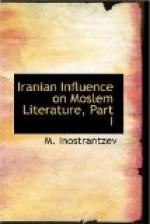[Footnote 1: On the constitution of the Sasanian government, see A. Christensen, L’empire des Sasanides, le peuple, l’etat, la cour, 1907.]
The Iranophile tendencies which dominated the Sasanian epoch developed in intimate cooperation with the State religion (Mazdaism) and the Parsi priesthood. Among the latter continued the production of literary works. Besides, the redaction of the sacred books was completed in these times. Among them were conserved and propagated Persian ethical ideals, which found expression in literary forms, in ethico-didactic tracts, like those which we notice just in the same circles in later times. To the same end were preserved national traditions and ritual, some of which had nothing to do with Mazdaism. The ethical ideals of the church found strong support in the feudalistic circles comprising the larger and the smaller landholders, the dehkans who, with particular zeal, preserved ancient heroic traditions.
Alongside of these national currents in the Sasanian empire there operated in full force those factors of cultural exchange of which we spoke above. Of those factors the most important that deserve our attention are questions regarding education and instruction. In this connection, Sasanian Persia found itself under powerful influences from the West. There are sufficient reminiscences of neo-Platonic exiles from Greece at the Sasanian Court and of the school of medicine in which the leading part belonged to Hellenic physicians. At the same time in the same field we have to examine other influences. For Sasanian Persia did not remain stranger to the sciences of India. We have information regarding the renascence of the activity of the translators of scientific works into the Persian language and the tradition of this activity survived down to the Moslem times. In connection with this theoretical scientific activity stood high perfection in exterior culture issuing to a considerable degree from exchange of materials. And even here the Sasanian tradition has survived the dynasties; in the study of the commerce and industry as well as the art of the Moslem epoch we have necessarily to refer back to the preceding times of the Persian history.
In pre-Moslem Arabia the high development of the civilisation of Sasanian Persia was well known. Among the subjects of the great Persian sovereigns in the western provinces of their empire there were a large number of Arabs who in commercial intercourse carried, to tribes of the Syrian desert and further south to the Arabian peninsula, reports regarding the great Iran Shahar. Not only legends of the heroic figures of the Iranian epic—Rustam and Isfandiar—but religious views and persuasions of the Persians found a place and were spread among the Arab clans. Thus we know that “fire-worshippers” were settled among the Arab tribe of the Temim.[1]
[Footnote 1: See for example Ibn Rustah (B.G.A. VII, p. 217, 6-9).]




